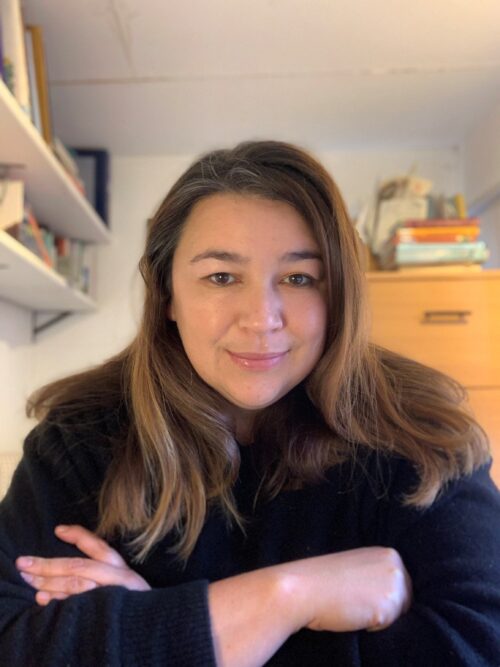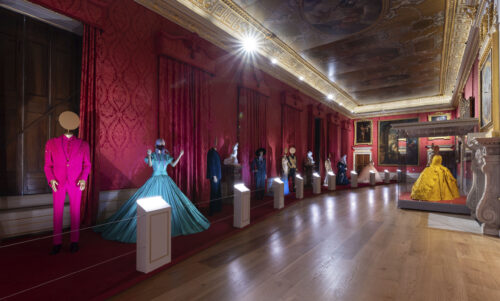Telling Royal Tales: Polly Putnam’s Experience as Collections Curator and Bridgerton Advisor
Date: 2/09/2025
We recently caught up with Polly Putnam (Theology, 2000) as part of an interview for Regent’s Now 2024! Polly is a Collections Curator for Historic Royal Palaces. As Polly puts it, it is her job to ‘tell the story of the palaces’ through the objects held in their collections, and through the buildings themselves. She has specific responsibility for Kew Palace, where she tells the stories of King George III and Queen Charlotte. Recently, Polly was a historical advisor on the hit Netflix series, Queen Charlotte: A Bridgerton Story.

What does the everyday look like as Collections Curator?
It’s such a cliché thing to say, but every day really is different, not least because I work across different sites – Kew Palace, Hampton Court, Kensington, the Tower of London. I do quite a lot of mad stuff; so many different things. The best days are those where I can spend time in the stores or the conservation studio. It’s a real privilege. Getting so close to the objects – you can appreciate them in so many ways, such as for the craftsmanship. I particularly look after 18th-century historic dress and the collection includes some of the greatest fashions ever made, such as dresses made from mantua. Mantua is such a high-quality fabric that the person who wove it would only be able to weave an inch or two a day. Some of the objects, especially the dress, are very emotive. For example, we hold the last jacket ever worn by King George III. Towards the end of his life, he was mentally and physically incapacitated at Windsor, where he had been since 1811. The jacket has been altered to accommodate the stoop of an old man, and there are still saliva and vomit stains on it. Because dress is worn so closely to the body, they’re incredibly personal objects. There’s a beauty and a sadness that you see in these objects. So, a key part of my job is to think carefully about how we present them – about how we tell their story.
What is the weirdest or most wonderful object you’ve worked with?
Recently we bought an apron that belonged to Queen Charlotte’s dresser. It’s not the easiest object to read when it’s lying flat – it looked like a glorified tea towel. With the conservators, we created a dress to go underneath the apron. It was only when making this dress that we could date the apron, because we learned a lot about its form. We also learned a lot about Mrs Thielcke, the dresser. She is a rather well-known servant because her duties are outlined in Francis Burney’s memoirs and she is also mentioned in Vanity Fair and the letters of one of Queen Charlotte’s ladies-in-waiting. But when we created the dress and paired it with the apron, we learned how big Mrs Thielcke was: really quite tall, and she had an enormous bosom! It really felt like we were bringing this individual back to life, bringing back the untold parts of her story, of who she was, for people to see. I’m really quite fond of that object.

You recently worked as a historical advisor for Queen Charlotte: A Bridgerton Story – how did you end up doing that?
That came about because I knew one of the historical consultants who worked on Bridgerton series one and two. She didn’t have time to consult for Queen Charlotte and she suggested they work with me. I was basically Shonda Rhimes’ personal historian. I would answer any queries she had during filming, and I also wrote reports on the ‘madness’ of King George III. With series like Bridgerton, we accept that it won’t be the most historically accurate. But by having historians on board, the team showed that they have made choices and not mistakes.
How do you feel about the portrayal of King George III in the series?
I was really pleased with the portrayal of George for two main reasons. First, because they told quite an empathetic story. I showed them the accounts of the King’s treatment and they took it quite seriously. Some of the scenes are dramatised, but the mental treatments were really cruel – like the ‘morality’ method, where he would be punished for having an episode by not being allowed to see his family that day. Secondly, Shonda had already picked up on the fact that George III was very interested in science, but what she didn’t know about was his interest in farming. I was really pleased to contribute that aspect of his personality to the script and storyline. After that, they included several topless ‘sexy’ farming scenes, and there’s actually quite a funny story. Corey Mylchreest (the actor playing George III), when I was introduced to him said, “Oh, so it’s your fault that I suddenly had to see a personal trainer?”
How do you feel about series like Bridgerton and the portrayal of historical times and people on the screen?
Well, no one had really heard of Queen Charlotte before Bridgerton. The renewed interest in these characters, for me, is a chance to say, “Yes! You should learn about Queen Charlotte because actually she’s quite an interesting character.” In some ways, Charlotte was incredibly nerdy – she was very interested in science; she surrounded herself with female intellectuals; her life was all about continuous lifelong learning. She even wrote privately to her best friend to say something along the lines of, ‘If we were given the same education as men, we could reign as well as them.’ Charlotte was living at a time when feminism was being born, and although she’s not at the centre of it she is a part of that thought exercise and is thinking about these things for herself. It’s great that people are interested in these characters as real-life people, and are taking an interest in learning more.
What other historical time period or topic would you like to see explored in a Netflix series?
There is a wonderful book by Gretchen Gerzina about Black England in the 18th century. On screen, a lot of the representation of black history is dominated by the American experience and Civil Rights Movement. I would quite like to see the 18th-century Black British experience portrayed on television because it was so incredibly rich. At the time, the Black population in Britain had their own spaces and were developing their own independent cultures.
And finally, switching track, what is your favourite Regent’s memory?
I’ll tell you a story, and I’m really quite proud of this. It was Bonfire Night in first year, and I’d been quite inspired by my father’s tales of his youthful hijinks, so I bought a big standing firework and set it off in the Quad. Lots of people found this funny, but somebody reported it and I was sent to the acting Principal Tim Bradshaw’s office, who took it very seriously. In the end, I got away with a £50 fine, which my father actually paid – he said he’d never been more proud of me! I’m also very lucky to have close friends that I met at Regent’s; a bunch of us meet up a couple of times every year. Regent’s might not be the grandest of colleges, but I’d say it’s one of the friendliest.
_______________
With thanks to Polly for talking to us about what it’s like to be a curator, Bridgerton inside secrets, and Regent’s hijinks. Adapted from Regent’s Now 2024 article, pp. 24-5.